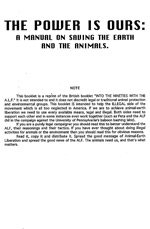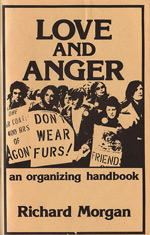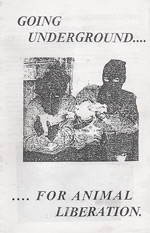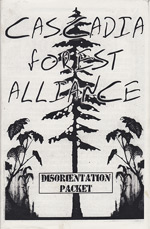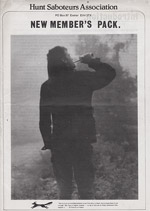» Next Entries
The Archives
-
One-off publications
The Power is Ours
05.18.11 | PermalinkThe Power is Ours (Early 1990s, North America)
As stated previously on our site, the early 90s saw an effort to spread the use of underground tactics via the distribution of cheap, zine format how-tos. One such attempt, The Power is Ours, was basically a reprinting of the British Into the 90s with the ALF.
The only real difference was a new lay-out and an introduction stating that the manual was somehow meant to bring together activists working on either side of the law. How this was to be accomplished is unclear. The publication contains almost no information on how those who utilize illegal means can advance the campaigns of traditional, legal protestors, or vice-versa.
While The Power is Ours fails in that goal, it does contain good excerpts from other primers, including a small piece about a raid carried out against the Oxford University vivisection program where 64 cats were rescued, and instructions (which, due to federal law, we have omitted) on building the pocket sized incendiary device that destroyed England’s fur trade in the 80s and 90s. Despite its limitations, this zine provides an interesting look into the way that illegal tactics are developed and spread.
…
-
One-off publications
How to Sink Whalers, Driftnetters, and Other Environmentally Destructive Ships
05.15.11 | PermalinkHow to Sink Whalers, Driftnetters, and Other Environmentally Destructive Ships (1993, Chica, CA. USA)
The scuttling of ships used to harm the ocean has a long and proud tradition in our movement. Classically, large boats were sunk with limpet mines attached magnetically to their hulls, but another method became popular in 1986 when David Howitt and Rod Coronado sank two boats in harbor in Iceland by opening the sea water intake valves and allowing the ocean to claim these destructive vessels. Their method, originally published as an epilogue in later editions of Dave Foreman and Bill Haywood’s Ecodefense, was later excerpted for publication in this little zine format gem.
…
-
Books
Love and Anger, 1st and 2nd Editions
05.03.11 | PermalinkLove and Anger, 1st and 2nd Editions (1980?, Westport, CT. USA)
“Animals have rights, interests, desires, and needs equal, within the context of their lives, to those of humans, and we have an obligation to recognize this, and act accordingly. Animal Rights is a philosophical orientation, and a practical necessity if creatures are to be spared the systematic cruelty to which they are currently subjected. But perhaps most importantly, the designation of and agitation for animal rights is part of a revolutionary process aimed at restructuring the major institutions of our society. Indeed, in struggling to change the way humans treat animals, and one another, we work towards nothing less than the transformation of the world.”
– Richard Morgan, from the introduction.
For the last several years, I have been trying to understand why the animal rights movement rode a wave of success in the early 80s, only to fall so sharply by the end of the decade. This inquiry has led me to read old books and magazines, to interview participants from that time period, and even to reading the history of other causes in an attempt to find parallels in their peaks and troughs. I still have not arrived at a conclusive answer to the question, and it appears that many factors played a part in our recession. What is more clear, though, is that one figure played a major role in our rise, only to be quickly forgotten. His name is Richard Morgan, and after working towards civil rights and an end to the war in Vietnam, he took up the cause of animal rights in the late 1970s.
Early figures in the movement speak of Morgan as a pioneer, and his group, Mobilization for Animals, planned some of the largest and most visible demonstrations of the time, drawing thousands of people to multiple locations across the United States. He introduced his organizing model in 1979 with the the first edition of Love and Anger, a book which many people in the fledgling animal rights community cited as their inspiration to start a local group.
Written in a style that blends 70s leftism with 80s self-help jargon, Love and Anger can, at times, be a frustrating read. Morgan certainly has a touch of the arrogant liberalism that repulsed the generation of activists that followed his into the 90s. Scattered throughout the book are unsupportable claims, like American pacifists ending the war in Vietnam with sit ins, and new-agey feel good calls for demonstrations to provide “spiritual nourishment.” Some of the book’s advice is remarkably egalitarian, including calls for work within a group to rotate and for everyone, even supposed leaders, to do “shit work.” But some of the book is strangely authoritarian, with calls for “marshals” at demonstrations to squelch the spontaneous actions of others present. If a reader can get past these snags this book also contains a lot of wisdom.
Written at a time when there was almost no movement to speak of in the United States, the author set out to make a handbook to teach people who had never held a sign before to grow a resistance from scratch. He was concerned about the personal and political development of each new member of this tiny cause, and wanted them to think big. Four years before the first civil disobedience action for animal rights (which took place in New York at the Macy’s Fur Department, not in Sacramento as widely reported elsewhere), Richard Morgan wrote about developing personal courage to face law enforcement and overcome private doubts about organizing ability. He gave practical advice on bringing out large numbers to demonstrations, making literature, contacting media and writing press releases, and other basics that helped make animal rights the breakout issue of the 1980s.
Richard Morgan disappeared from activism in the mid 80s. Attempts to track him down have been fruitless, and even his old friends don’t seem to know what happened to him. But, before he walked out of view, he left us with some powerful advice. I hope young activists will read this book with a critical eye, and consider how these words helped lay the foundation for the movement they participate in today.
…
-
One-off publications
An Animal Liberation Primer, 2nd and 3rd Editions
04.17.11 | PermalinkAnimal Liberation Primer, 2nd and 3rd editions. (Publishing date unknown, materials compiled from England, the United States, and Canada)
Groups operating outside the confines of the law, especially those who utilize a leaderless resistance model, often resort to self published manuals to spread ideology and practical advice on tactics. For the Animal Liberation Front, the Animal Liberation Primer series was the equivalent of the Irish Republican Army’s volunteer handbook. Spread far and wide by sympathetic activists, touring punk bands, and ALF supporters groups, this tiny guide put the power of direct action into the hands of thousands of people.
The Primer focused on security culture, direct action philosophy, tactical decision making between animal rescues and economic sabotage, and more direct how-to directions. Many of the instructions contained in this edition had to be redacted from our archive in order to comply with federal laws on distributing information detailing how to commit arson. Other than standard warnings against lighting fires which might harm animals, including humans, little attention was paid to the long term implications of burning down buildings, including the additional resources available to law enforcement to slow a burgeoning movement for animal liberation. While not ignoring the issue of consequences completely, it was a failure of the authors to not dedicate more space to examining the long term effects of a direct action campaign on public support, repression, and momentum. That being said, one would expect a greater degree of heavy handed, ideologically rigid language from a zine such as this. Fortunately the tone remains determined and confident without titling towards cultish.

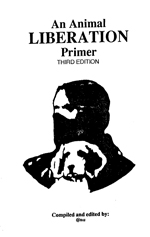
…
-
One-off publications
Going Underground for Animal Liberation
04.05.11 | PermalinkGoing Underground for Animal Liberation (England, 1993)
The early part of the 1990s saw a number of small booklets written anonymously by participants in illegal direct action and distributed widely to sympathizers “above ground.” These booklets varied in quality and ranged from interviews with people who had undertook small scale sabotage, to more theoretical works that dealt with the direction the authors felt the movement should go. Going Underground follows that latter formula, and offers thoughts on the meaning of animal liberation, the value of direct action, and the security measures one should practice before undertaking that path. The contents of this small zine were largely applicable to a specific time period and geographical place, but relevant ideas are sprinkled here and there inside its pages.
…
-
One-off publications
Nighttime Gardener
03.25.11 | PermalinkNighttime Gardener: A Guide for the Shy Gardener in North America (2000, United States.)
Originally released to coincide with the WTO protests, Nighttime Gardener quickly became the standard primer on anti-bioengineering crop pulls. These actions, which were once popular all across the world, were aimed at preventing GM cross contamination with other agriculture, and also at causing delays in research of “Frankenfoods.”
There has been an unfortunate slow down in sabotage of genetically-manipulated crops in the last decade. This may be due in part to the overwhelming public sentiment against such technologies as “terminator seeds,” or it may be another sad byproduct of the Green Scare. Regardless, the hey day of then anti-GM movement was well documented, and we will do out best to keep it archived here at TALON.
…
-
One-off publications
Cascadia Forest Alliance Disorientation Manual
03.23.11 | PermalinkCascadia Forest Alliance Disorientation Manual. (2003, Oregon, USA.)
From the 1980s until present environmentalist have done a number of high profile campaigns to protect wilderness areas in the Northwest of the United States. I have a special affinity for these actions. Having grown up in Eugene, OR in the 80s, I remember seeing college kids from the University with their Earth First! patches, going to coffee shops where groups of crusties, hippies, and career activists hunkered down in dark corners planning blockades, and going to mailing parties at the Journal house. The wild areas of what is known around those parts as Cascadia are amongst the most beautiful and important on earth, and I consider them home.
Militancy in defense of the planet is an artform, and this publication from the Cascadia Forest Alliance aimed to bring the basics to the masses who showed up at camps in the woods, eager to get active. It explains the basics of anti-oppression policies, direct action, and security culture. Sadly, it also contains a section on consensus decision making. The staff of Conflict Gypsy would like to go on record as being opposed to consensus decision making in groups. The idea of consensus allows a single obstructionist to essentially become a dictator who blocks the will of the rest of the organization. The person who least agrees with the goals and tactics of the group can slow progress, and the earth doesn’t have the time to accommodate their concerns. We have seen consensus groups regularly push out the most talented activists and organizers because a tyranny of the minority is created by a system meant to empower everyone.
Despite what we see as a flaw in their logic, CFA did wonderful work, and this packet sets the standard for what forest activism primers should be.
…
-
One-off publications
Hunt Saboteurs Association New Members Pack
03.14.11 | PermalinkHunt Saboteurs Association New Members Pack (1987. Exeter, England.)
The Hunt Saboteurs Association is among the most important organizations in the history of animal rights. Starting in 1963, it was one of the first protest organizations for animals in the modern era. More importantly, its means were always direct action oriented, and the atmosphere of local HSA meet ups encouraged humans to examine how to best interact with animals.
Years prior to the publication of Animal Liberation (a book which the media falsely credits with launching the animal rights movement), “sabs” were out in the fields of England laying false scents, blowing horns to confuse hunting dogs, and even sometimes sabotaging the vehicles of hunt supporters. It was this type of activity which led to some members of the HSA to begin considering how else they could contribute to the movement. It is common knowledge that a small group of HSA members formed the Band of Mercy, an underground organization that eventually morphed into the Animal Liberation Front. What is less known is the role that the organization played developing the people who would go on to shape our ideas and tactics.
Conflict Gypsy will be presenting a wide variety of hunt saboteur literature on the site in the coming months. In the meantime, this starter pack is a good primer on the philosophies and tactics of the HSA.
…
» Next Entries
